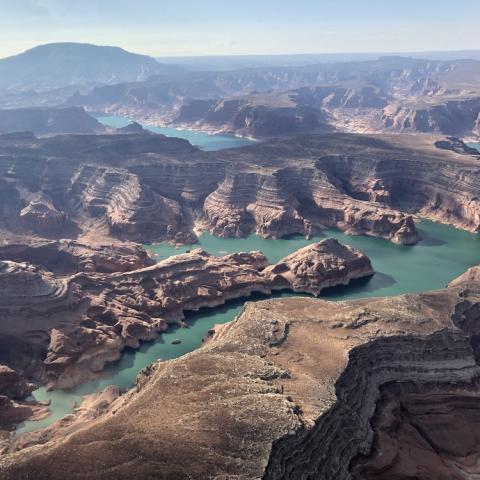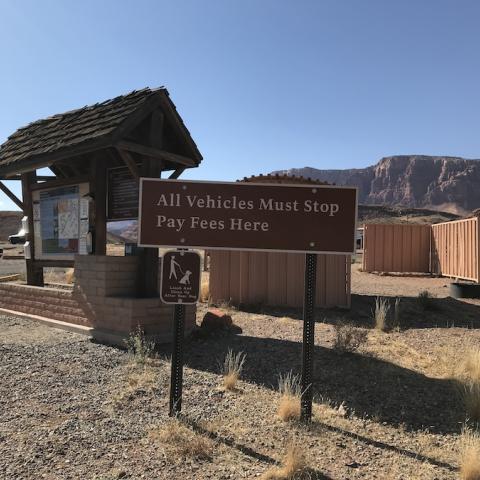
A painting depicting an Early Jurassic scene from the Navajo Sandstone desert preserved at Glen Canyon NRA. A small team of paleontologists worked with artist Brian Engh to provide a technically accurate depiction of the rare and enigmatic tritylodonts (close mammal relatives) discovered in March during low water levels of Lake Powell/NPS
Rising out of the low waters of Lake Powell at Glen Canyon National Recreation Area earlier this year was a roughly 180-million-year-old fossilized bone bed that contained remains of mammal-like creatures.
The tritylodontid bone bed was found in the Navajo Sandstone on the Utah side of the NRA. These fossils are one of the more important fossil vertebrate discoveries in the United States this year, according to the National Park Service. The discovery included fossilized bones and teeth, which are rare in the geologic formation known as the Navajo Sandstone within the Glen Canyon Group, the agency added.
The fossils were discovered in March when paleontologists were documenting fossil tracksites. The site had been submerged by Lake Powell’s fluctuating water levels and was only found because the paleontologists were in the right place at the right time before annual snowmelt filled the lake. Field teams were only able to access the location for a very short window of time (approximately 120 days) to recover the fossils. Additionally, another rare bone bed was discovered nearby in the slightly older Kayenta Formation.
The crew collected several hundred pounds of rocks encasing the fossil bones and skeletons. These will be scanned with X-ray computerized tomography at the University of Utah South Jordan Health Center, mechanically prepared and studied at St. George Dinosaur Discovery Site at Johnson Farm by the lab and collections crew volunteers, with help from Petrified Forest National Park and the Smithsonian Institution.
The fossils will become part of the Glen Canyon NRA museum collections to be housed at the Prehistoric Museum in Price, Utah. Studying these fossils will help paleontologists learn more about how early mammal relatives survived the mass extinction at the end of the Triassic Period and diversified through the Jurassic Period.

Field crews discovered a fossil bone bed contained remains of a tritylodontid in Glen Canyon National Recreation Area/NPS
Andrew Milner, site paleontologist and curator at SGDS, is the lead author of a manuscript describing a related site to be published either on National Fossil Day or shortly thereafter in the open access journal, Geology of the Intermountain West. This manuscript will be available at the this site.
The public can learn more about this and other recent Glen Canyon NRA fossil discoveries at an October 11 National Fossil Day interpretive event being held at Zion National Park. The invited speaker is Milner, who was part of the crew that made the rare discoveries and is assisting with their curation and research.
The towering geologic formations that surround Lake Powell are home to a vast suite of unexplored fossil remains, making Glen Canyon NRA one of the National Park Service’s most significant areas for paleontological research. The most famous and abundant fossils known from Glen Canyon NRA are the footprints of meat-eating dinosaurs in the Glen Canyon Group. This series of sedimentary rocks, named after their exposures along the canyon itself, were laid down by rivers, lakes, streams and deserts from the Late Triassic Epoch through the Early Jurassic Epoch. One of the largest mass extinctions in Earth’s history happened during this period.



 Support Essential Coverage of Essential Places
Support Essential Coverage of Essential Places






